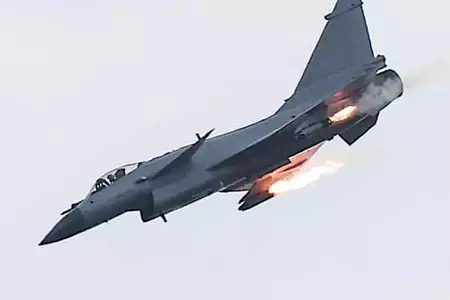- Joined
- Apr 14, 2011
- Messages
- 20,183
- Points
- 113
MediaCorp should hire this kind of no horse run fork tongue talent!
By: Brandon J. Weichert
In the run-up to open hostilities between the two warring subcontinental powers, many experts simply assumed that the Indians would trounce their Pakistani neighbors, given their larger size, manpower, and military budget.
Yet in the opening hours of the conflict, the Pakistanis seem to have gotten the better of their Indian rivals. Details about the fighting are still somewhat scarce, but in the early hours of Wednesday, May 7, 2025, Islamabad made a series of incredible announcements about aerial victories over India—which India, conspicuously, has made no effort to refute.

The Chinese-made jet bringing down Indian fighters in PakistanNikkei Asia

He Chose To Embark On A Career Switch In His 60s!MyCareersFuture
In short, the recent battle between Pakistani and Indian forces ended in an unambiguous victory for Pakistan. It is also a warning to the West that China’s military technology, as seen in Pakistan, should not be underestimated.
China’s PL-15 is an active radar-guided, long-range air-to-air missile. Designed by the Luoyang-based China Airborne Missile Academy (CAMA), it serves as a beyond-visual-range (BVR), weapon for the People’s Liberation Army Air Force (PLAAF), People’s Liberation Army Naval Air Force, and the Pakistani Air Force.
First test-fired in 2011, China’s PL-15 was first spotted in 2013 mounted on a Chengdu J-20 “Mighty Dragon” fifth-generation warplane. The missile entered service between 2015 and 2017. Within the Pakistan Air Force, the PL-15 is equipped on their Chinese-produced JF-17 Block III warplanes, as well as the J-10CE fighters—the class of warplane that, according to initial reports, shot down all those IAF birds.
The PL-15 is designed to engage high-value targets like airborne early warning and control aircraft, tankers, and fighters at extended ranges, replacing the older PL-12 missile as the standard BVR missile for Chinese and Pakistani forces. The missile employs a dual-use solid-fuel rocket motor, though its export variant, the PL-15E—likely used in the dogfight on Wednesday—uses a slightly different propellant or motor. Some sources argue that the PL-15s can achieve speeds of up to Mach 5, though this is unconfirmed.
Most analysts believe that the Chinese domestic PL-15 model is equivalent to the Anglo-French MBDA Meteor missile. It is also meant to compete against the U.S.-made AIM-120D AMRAAM. In fact, China’s creation of the PL-15 likely prompted the U.S. military to create the AIM-260 and the AIM-174B to counter it.
These missiles feature hybrid guidance systems, including the Inertial Navigation System (INS) along with a mid-course two-way datalink for updates from the launching aircraft or airborne command and control planes. There is an onboard active electronically scanned array (AESA) radar seeker with active and passive modes for terminal homing, offering high precision and resistance to countermeasures.
Folding fins designed for an internal carriage in stealth aircraft, such as the J-20, are one of the defining features of this missile. The PL-15E variant has folding rear fins to increase internal payload capacity; this gives it a reduced range compared to its domestic PL-15 Chinese cousin.
It is still the earliest phase of the conflict, and further clashes are likely. India, at least on paper, has many advantages over their Pakistani neighbors. But the successful attacks by the Pakistani planes indicate that Islamabad is playing for keeps. What’s more, it is a warning to the Americans that Chinese missile technology should not be underestimated—especially as the Americans and Chinese circle each other for a future battle over Taiwan.
 What’s my car worth? Online Calculator for Car ResaleSponsored | TrendingResults
What’s my car worth? Online Calculator for Car ResaleSponsored | TrendingResults
How Chinese Missiles Routed India’s Air Force Over Pakistan
May 8, 2025By: Brandon J. Weichert
The recent battle between Pakistani and Indian forces ended in an unambiguous victory for Pakistan.
Now that the latest India-Pakistan War appears to be underway, we are getting a glimpse at how the two militaries are squaring off against each other. Thus far, the conflict is not playing out the way that many—this analyst included—assumed it would.In the run-up to open hostilities between the two warring subcontinental powers, many experts simply assumed that the Indians would trounce their Pakistani neighbors, given their larger size, manpower, and military budget.
Yet in the opening hours of the conflict, the Pakistanis seem to have gotten the better of their Indian rivals. Details about the fighting are still somewhat scarce, but in the early hours of Wednesday, May 7, 2025, Islamabad made a series of incredible announcements about aerial victories over India—which India, conspicuously, has made no effort to refute.

The Chinese-made jet bringing down Indian fighters in PakistanNikkei Asia

He Chose To Embark On A Career Switch In His 60s!MyCareersFuture
Understanding Pakistan’s PL-15 Air-to-Air Missile
Namely, Islamabad claimed that Chinese-made PL-15 air-to-air missiles—probably fired by Pakistan’s Chinese-provided J-10C warplanes—downed three Indian Air Force (IAF) French-built Rafale jets, one Indian-built Su-30MKI, and one Russian-built MiG-29. These planes—and in particular the Rafales—were among some of the strongest warplanes in the IAF.In short, the recent battle between Pakistani and Indian forces ended in an unambiguous victory for Pakistan. It is also a warning to the West that China’s military technology, as seen in Pakistan, should not be underestimated.
China’s PL-15 is an active radar-guided, long-range air-to-air missile. Designed by the Luoyang-based China Airborne Missile Academy (CAMA), it serves as a beyond-visual-range (BVR), weapon for the People’s Liberation Army Air Force (PLAAF), People’s Liberation Army Naval Air Force, and the Pakistani Air Force.
First test-fired in 2011, China’s PL-15 was first spotted in 2013 mounted on a Chengdu J-20 “Mighty Dragon” fifth-generation warplane. The missile entered service between 2015 and 2017. Within the Pakistan Air Force, the PL-15 is equipped on their Chinese-produced JF-17 Block III warplanes, as well as the J-10CE fighters—the class of warplane that, according to initial reports, shot down all those IAF birds.
The PL-15 is designed to engage high-value targets like airborne early warning and control aircraft, tankers, and fighters at extended ranges, replacing the older PL-12 missile as the standard BVR missile for Chinese and Pakistani forces. The missile employs a dual-use solid-fuel rocket motor, though its export variant, the PL-15E—likely used in the dogfight on Wednesday—uses a slightly different propellant or motor. Some sources argue that the PL-15s can achieve speeds of up to Mach 5, though this is unconfirmed.
Most analysts believe that the Chinese domestic PL-15 model is equivalent to the Anglo-French MBDA Meteor missile. It is also meant to compete against the U.S.-made AIM-120D AMRAAM. In fact, China’s creation of the PL-15 likely prompted the U.S. military to create the AIM-260 and the AIM-174B to counter it.
These missiles feature hybrid guidance systems, including the Inertial Navigation System (INS) along with a mid-course two-way datalink for updates from the launching aircraft or airborne command and control planes. There is an onboard active electronically scanned array (AESA) radar seeker with active and passive modes for terminal homing, offering high precision and resistance to countermeasures.
Folding fins designed for an internal carriage in stealth aircraft, such as the J-20, are one of the defining features of this missile. The PL-15E variant has folding rear fins to increase internal payload capacity; this gives it a reduced range compared to its domestic PL-15 Chinese cousin.
Pakistan Won Using China’s Defense Technology
Nevertheless, the Pakistanis have deployed this system with lethal impact in their growing conflict with India. Their successful engagement downing five IAF warplanes is a tremendous blow to the IAF, as well as to India’s military. While any military engaging in a near-peer conflict can expect large numbers of its airplanes to be damaged or destroyed, the fact of the matter is that the Pakistanis were not supposed to be this effective.It is still the earliest phase of the conflict, and further clashes are likely. India, at least on paper, has many advantages over their Pakistani neighbors. But the successful attacks by the Pakistani planes indicate that Islamabad is playing for keeps. What’s more, it is a warning to the Americans that Chinese missile technology should not be underestimated—especially as the Americans and Chinese circle each other for a future battle over Taiwan.
 What’s my car worth? Online Calculator for Car ResaleSponsored | TrendingResults
What’s my car worth? Online Calculator for Car ResaleSponsored | TrendingResults
